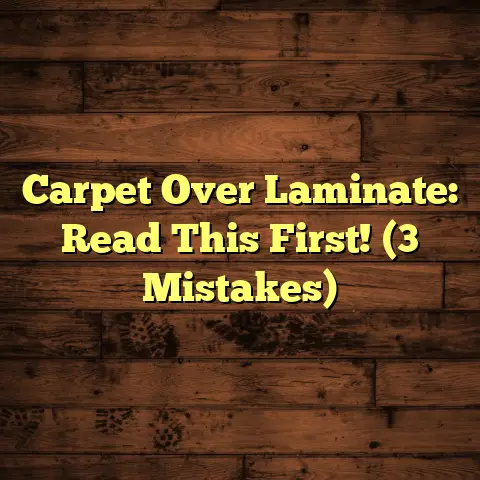Clean Bathroom Tiles: What To Use? (6 Scrubbing Sins!)
Bathrooms, especially in homes with kids, are like miniature science labs. Think about it: bath time bubbles, toothpaste explosions, and, well, let’s just say “creative” uses of the toilet.
All this activity can lead to some serious grime buildup on your bathroom tiles. But it’s not just about aesthetics. Dirty tiles can harbor mold, bacteria, and other nasties that can be particularly harmful to children with their still-developing immune systems.
Maintaining clean tiles isn’t just about a sparkling bathroom; it’s about creating a safe and healthy environment for your little ones. So, how do we tackle this? Well, that’s what I’m here to guide you through.
In this article, we’ll dive into the world of bathroom tile cleaning, but not just any cleaning. I’m going to help you avoid the common pitfalls, the “Scrubbing Sins,” that can actually damage your tiles and create more problems than they solve.
Ready to get started? Let’s jump in!
Section 1: Understanding Bathroom Tile Materials
Before you even think about grabbing a scrub brush and your favorite cleaner, it’s crucial to understand what your bathroom tiles are made of. Different materials require different cleaning approaches, and using the wrong products can lead to permanent damage.
Here’s a breakdown of the most common types of bathroom tiles:
-
Ceramic Tile: This is probably the most common type you’ll find. Ceramic is durable, relatively inexpensive, and comes in a wide variety of styles. However, it’s also porous, meaning it can absorb water and stains if not properly sealed.
-
Porcelain Tile: Think of porcelain as ceramic’s tougher cousin. It’s denser, less porous, and more resistant to water and stains. Porcelain is a great choice for bathrooms with heavy foot traffic or areas prone to moisture.
-
Stone Tile: This includes materials like marble, granite, slate, and travertine. Stone tiles offer a luxurious look, but they also require special care. Many stone tiles are sensitive to acidic cleaners and can be easily scratched.
-
Vinyl Tile: Vinyl tiles are a budget-friendly option that’s also water-resistant and easy to clean. They’re a good choice for kids’ bathrooms because they’re durable and can withstand a lot of wear and tear.
Why does knowing the material matter?
Imagine using a harsh, abrasive cleaner on a delicate marble tile. You’d likely end up with scratches and etching, ruining the finish. Similarly, using the wrong cleaner on ceramic tile can damage the sealant, making it more susceptible to staining.
And with kids using the bathroom, well, you can imagine the staining potential! Juice spills, muddy footprints, and who-knows-what-else can quickly penetrate unsealed tiles.
Challenges with Different Tile Types
| Tile Type | Cleaning Challenges |
|---|---|
| Ceramic | Porosity, staining, grout discoloration |
| Porcelain | Grout discoloration, potential for scratching with abrasive cleaners |
| Stone | Sensitivity to acidic cleaners, scratching, water stains |
| Vinyl | Potential for discoloration with harsh chemicals, wear and tear over time |
Pro Tip: If you’re unsure what type of tile you have, check the original installation paperwork or ask a professional flooring contractor. It’s always better to be safe than sorry!
Section 2: The Importance of Choosing the Right Cleaning Products
Okay, now that we’ve covered the different types of tiles, let’s talk about cleaning products. The market is flooded with options, each promising sparkling results. But which ones are actually safe for your tiles and, more importantly, your kids?
I generally categorize bathroom tile cleaners into three main groups:
-
Natural Solutions: These are your DIY options, using ingredients like vinegar, baking soda, lemon juice, and essential oils.
-
Chemical-Based Cleaners: These are your store-bought cleaners, often containing ingredients like bleach, ammonia, and detergents.
-
Homemade Solutions: A mix of both natural and chemical solutions.
Natural Solutions
- Pros:
- Eco-friendly
- Generally safe for kids and pets
- Inexpensive
- Cons:
- May not be as effective on tough stains
- Can require more elbow grease
- Some natural ingredients (like lemon juice) can be acidic and potentially damage certain stone tiles.
Chemical-Based Cleaners
- Pros:
- Highly effective at removing dirt, grime, and mold
- Often disinfect and sanitize surfaces
- Convenient and readily available
- Cons:
- Can contain harsh chemicals that are harmful to kids and pets
- May damage certain tile types
- Can release toxic fumes
- Can be expensive
Homemade Solutions
- Pros:
- Can adjust the content according to need.
- Effective at removing dirt, grime, and mold
- Often disinfect and sanitize surfaces
- Cons:
- Can damage certain tile types
- Can release toxic fumes
- Can be expensive
Safety First!
When it comes to cleaning products, especially around children, safety should always be your top priority.
-
Read the labels: This seems obvious, but it’s amazing how many people skip this step. Pay attention to warnings, precautions, and ingredient lists.
-
Avoid products containing:
- Bleach (sodium hypochlorite): Can cause skin and eye irritation, respiratory problems, and can be toxic if ingested.
- Ammonia: Can cause respiratory irritation and can be fatal if ingested.
- Phthalates: Endocrine disruptors that can be harmful to children’s development.
- Triclosan: An antibacterial agent that has been linked to hormone disruption and antibiotic resistance.
-
Opt for “green” or “eco-friendly” cleaners: These products typically use plant-based ingredients and avoid harsh chemicals. Look for certifications like EcoLogo or Green Seal.
-
Store cleaning products safely: Keep them out of reach of children, preferably in a locked cabinet.
Specific Product Recommendations
While I can’t endorse specific brands (due to potential conflicts of interest), I can offer some general recommendations based on my experience:
-
For ceramic and porcelain tiles: A mild dish soap and water solution is often sufficient for routine cleaning. For tougher stains, consider a baking soda paste or a specialized tile cleaner that’s safe for glazed surfaces.
-
For stone tiles: Look for pH-neutral cleaners specifically designed for natural stone. Avoid acidic cleaners like vinegar or lemon juice, as they can etch the surface.
-
For vinyl tiles: A multi-surface cleaner or a vinyl floor cleaner should work well. Avoid abrasive cleaners, as they can scratch the surface.
Remember: Always test a new cleaning product in an inconspicuous area before applying it to the entire surface. This will help you ensure that it doesn’t damage or discolor your tiles.
Section 3: The 6 Scrubbing Sins
Alright, let’s get to the heart of the matter: the “Scrubbing Sins.” These are the common mistakes I see homeowners make when cleaning their bathroom tiles, mistakes that can lead to damaged tiles, unhealthy environments, and a whole lot of frustration.
Sin 1: Using Abrasive Tools
I can’t tell you how many times I’ve seen homeowners attacking their tiles with steel wool, scouring pads, or stiff-bristled brushes. While these tools might seem effective at removing stubborn grime, they can actually do more harm than good.
Abrasive tools can scratch the surface of your tiles, especially softer materials like stone or vinyl. These scratches create tiny crevices that trap dirt and grime, making your tiles even harder to clean in the long run.
Instead, opt for:
- Soft cloths
- Microfiber mops
- Non-abrasive sponges
- Nylon-bristled brushes (for grout cleaning)
Sin 2: Overusing Harsh Chemicals
We talked about the dangers of harsh chemicals earlier, but it’s worth reiterating. Overusing strong cleaning agents like bleach or ammonia can not only damage your tiles but also release toxic fumes that can be harmful to your family, especially children.
Kids are more susceptible to the effects of these chemicals because their bodies are still developing. Exposure to harsh chemicals can lead to respiratory problems, skin irritation, and other health issues.
Instead, opt for:
- Diluted cleaning solutions
- “Green” or eco-friendly cleaners
- Natural cleaning methods (like vinegar and baking soda)
Sin 3: Neglecting Regular Maintenance
This is a big one. Many homeowners only clean their bathroom tiles when they’re visibly dirty. But by then, the grime has already had a chance to set in, making it much harder to remove.
Regular maintenance is key to preventing dirt buildup and stains. This is especially important in bathrooms used by children, where spills and messes are more frequent.
Instead, opt for:
- Wiping down tiles after each use
- Sweeping or vacuuming regularly
- Deep cleaning at least once a week
Sin 4: Ignoring Grout Care
Grout lines are like magnets for dirt, grime, and mold. They’re also notoriously difficult to clean. Neglecting your grout can lead to discoloration, staining, and even mold growth, which can be particularly harmful to children’s health.
Mold spores can trigger allergies, asthma, and other respiratory problems. Children are more vulnerable to these effects because their lungs are still developing.
Instead, opt for:
- Regular grout cleaning with a grout brush and a specialized grout cleaner
- Sealing grout to prevent water and stain absorption
- Using a grout pen to touch up discolored areas
Sin 5: Not Testing Cleaning Products
I mentioned this earlier, but it’s so important that it bears repeating. Before you slather a new cleaning product all over your bathroom tiles, always test it in an inconspicuous area first.
This will help you ensure that the product doesn’t damage or discolor your tiles or grout. It’s a simple step that can save you a lot of headaches (and money) in the long run.
Instead, opt for:
- Testing cleaning products in a small, hidden area (like behind the toilet or under the sink)
- Waiting 24 hours to see if there are any adverse reactions
- Following the manufacturer’s instructions carefully
Sin 6: Forgetting to Rinse Thoroughly
This is a common mistake that can leave your tiles looking dull and streaky. Residue from cleaning products can also make your tiles slippery, which is especially dangerous for children.
Instead, opt for:
- Rinsing tiles thoroughly with clean water after cleaning
- Using a clean, dry cloth to wipe away any excess water
- Making sure the floor is completely dry before allowing children to use the bathroom
Section 4: Tips for Effective Tile Cleaning
Okay, now that we’ve covered the “Scrubbing Sins,” let’s talk about how to clean your bathroom tiles effectively and safely. Here are some step-by-step instructions and tips tailored for parents and caregivers:
Step 1: Gather Your Supplies
You’ll need:
- A soft cloth or microfiber mop
- A non-abrasive sponge
- A nylon-bristled brush (for grout)
- Your chosen cleaning solution (see recommendations above)
- A bucket of clean water
- Rubber gloves (optional)
Step 2: Prepare the Area
- Remove any rugs, bath mats, or other items from the floor.
- Sweep or vacuum the floor to remove loose dirt and debris.
- Open a window or turn on the ventilation fan to ensure proper ventilation.
Step 3: Apply the Cleaning Solution
- Dilute your cleaning solution according to the manufacturer’s instructions (if applicable).
- Apply the solution to the tiles using a soft cloth or mop.
- For stubborn stains, let the solution sit for a few minutes before scrubbing.
Step 4: Scrub the Tiles and Grout
- Use a non-abrasive sponge to scrub the tiles, paying attention to areas with heavy dirt buildup.
- Use a nylon-bristled brush to scrub the grout lines, working in small sections.
- For tough grout stains, consider using a grout cleaner or a baking soda paste.
Step 5: Rinse Thoroughly
- Rinse the tiles and grout with clean water, making sure to remove all traces of the cleaning solution.
- Use a clean, dry cloth to wipe away any excess water.
Step 6: Dry the Floor
- Allow the floor to air dry completely before allowing children to use the bathroom.
- You can speed up the drying process by using a fan or opening a window.
Involving Children (Safely!)
Cleaning doesn’t have to be a chore! You can involve your children in the process safely by:
- Giving them age-appropriate tasks, like wiping down baseboards or organizing cleaning supplies.
- Turning on some music and making it a dance party.
- Using child-safe cleaning products and supervising their use.
- Making it a game! See who can spot the most dirt or who can scrub the fastest.
Establishing a Cleaning Routine
The key to maintaining clean bathroom tiles is to establish a regular cleaning routine. Here’s a sample routine you can adapt to your family’s needs:
- Daily: Wipe down tiles after each use to prevent water spots and soap scum buildup.
- Weekly: Deep clean tiles and grout using the steps outlined above.
- Monthly: Seal grout to prevent water and stain absorption.
Conclusion
So, there you have it: everything you need to know about cleaning bathroom tiles safely and effectively, especially when kids are involved. Remember, choosing the right products and methods is crucial for protecting your tiles, your family’s health, and your sanity.
A clean bathroom isn’t just about aesthetics; it’s about creating a safe and healthy environment for your children. By avoiding the “Scrubbing Sins” and following the tips I’ve shared, you can maintain a sparkling bathroom that your whole family can enjoy.
Now, go forth and conquer those dirty tiles! And remember, if you’re ever feeling overwhelmed, don’t hesitate to call a professional flooring contractor for help. We’re here to make your life easier (and your bathroom cleaner!).





